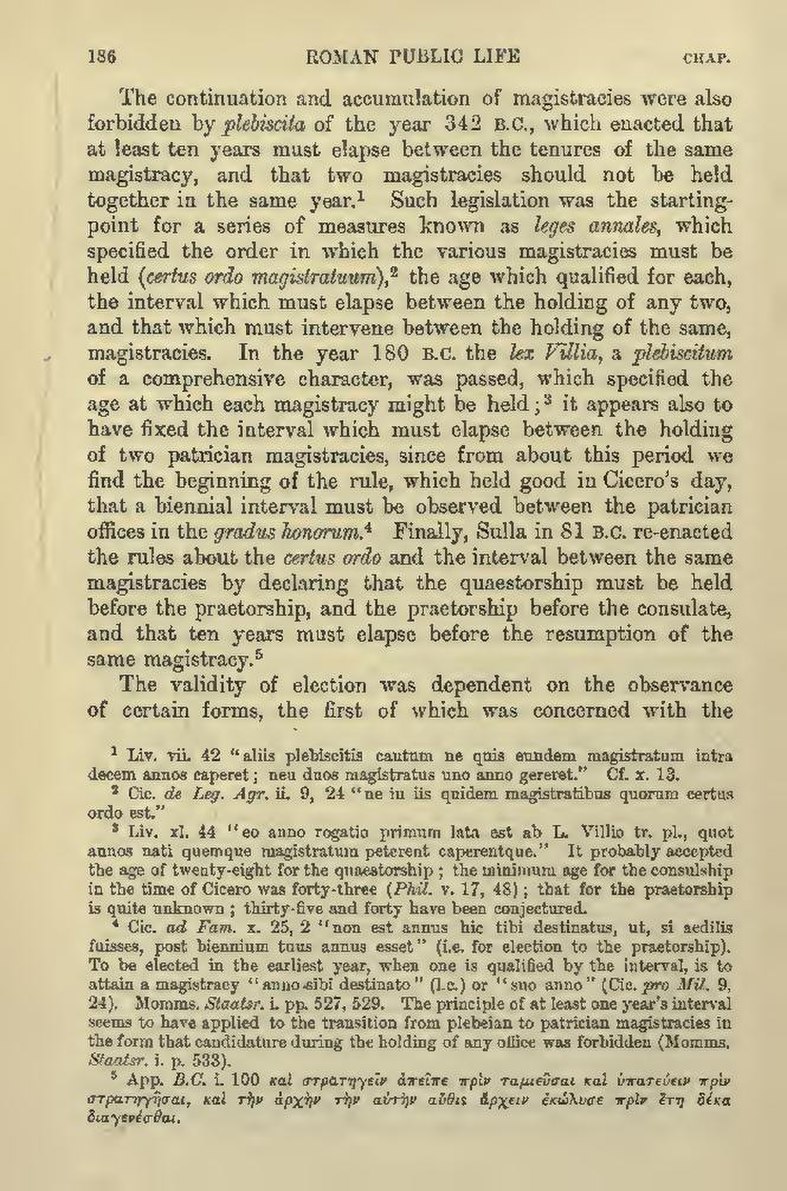The continuation and accumulation of magistracies were also forbidden by plebiscita of the year 342 B.C., which enacted that at least ten years must elapse between the tenures of the same magistracy, and that two magistracies should not be held together in the same year.[1] Such legislation was the starting-point for a series of measures known as leges annales, which specified the order in which the various magistracies must be held (certus ordo magistratuum),[2] the age which qualified for each, the interval which must elapse between the holding of any two, and that which must intervene between the holding of the same, magistracies. In the year 180 B.C. the lex Villia, a plebiscitum of a comprehensive character, was passed, which specified the age at which each magistracy might be held;[3] it appears also to have fixed the interval which must elapse between the holding of two patrician magistracies, since from about this period we find the beginning of the rule, which held good in Cicero's day, that a biennial interval must be observed between the patrician offices in the gradus honorum.[4] Finally, Sulla in 81 B.C. re-enacted the rules about the certus ordo and the interval between the same magistracies by declaring that the quaestorship must be held before the praetorship, and the praetorship before the consulate, and that ten years must elapse before the resumption of the same magistracy.[5]
The validity of election was dependent on the observance of certain forms, the first of which was concerned with the.]
- ↑ Liv. vii. 42 "aliis plebiscitis cautum ne quis eundem magistratum intra decem annos caperet; neu duos magistratus uno anno gereret." Cf. x. 13.
- ↑ Cic. de Leg. Agr. ii. 9, 24 "ne in iis quidem magistratibus quorum certus ordo est."
- ↑ Liv. xl. 44 "eo anno rogatio primum lata est ab L. Villio tr. pl., quot annos nati quemque magistratum peterent caperentque." It probably accepted the age of twenty-eight for the quaestorship; the minimum age for the consulship in the time of Cicero was forty-three (Phil. v. 17, 48); that for the praetorship is quite unknown; thirty-five and forty have been conjectured.
- ↑ Cic. ad Fam. x. 25, 2 "non est annus hic tibi destinatus, ut, si aedilis fuisses, post biennium tuus annus esset" (i.e. for election to the praetorship). To be elected in the earliest year, when one is qualified by the interval, is to attain a magistracy "anno sibi destinato" (l.c.) or "suo anno" (Cic. pro Mil. 9, 24). Momms. Staatsr. i. pp. 527, 529. The principle of at least one year's interval seems to have applied to the transition from plebeian to patrician magistracies in the form that candidature during the holding of any office was forbidden (Momms. Staatsr. i. p. 533).
- ↑ App. B.C. i. 100 [Greek: kai stratêgein apeipe prin tamieusai kai hypateuein prin stratêgêsai, kai tên archên tên autên authis archein ekôlyse prin etê deka diagenesthai
